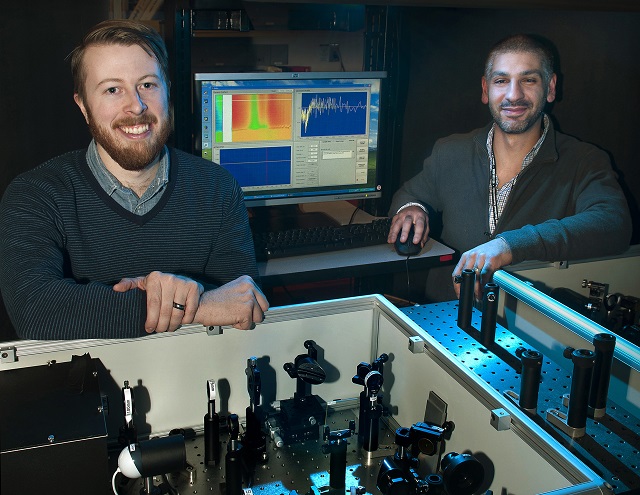 Postdoctoral fellow Erik Busby and Matt Sfeir with optical equipment they used to study charge carrier production in organic photovoltaic polymers at Brookhaven Lab's Center for Functional Nanomaterials.
Postdoctoral fellow Erik Busby and Matt Sfeir with optical equipment they used to study charge carrier production in organic photovoltaic polymers at Brookhaven Lab's Center for Functional Nanomaterials.
Researchers from the U.S. Department of Energy's Brookhaven National Laboratory and the Columbia University have collaborated to develop solar cell polymers that have multiplied electrical output.
When solar cells absorb light energy they lose some of it as heat. This is a challenge in attempts to improve the efficiency of solar cells. Hence, researchers have been trying to design new materials that have the capacity to convert more of the absorbed energy into electricity. Usually, one electrical charge carrier is produced per unit of light. However, in the present study, the team produced two electrical charge carriers per unit of light to recover some of the energy that is lost during the absorption process.
Critically, we show how this multiplication process can be made efficient on a single molecular polymer chain.
Physicist, Matthew Sfeir
Matthew Sfeir, who led the research at Brookhaven Lab's Center for Functional Nanomaterials (CFN), a DOE Office of Science User Facility. When two charges are on the same molecule, the light-absorbing materials that produce energy do not have to be in the form of perfect crystal arrays for producing more electrical charges. When the self-contained materials are dissolved in liquids they work efficiently and this holds promise for different types of processes such as “printing" of material like inks for producing solar-energy, and other industrial scale manufacturing processes.
"Singlet fission" is the production of two charges from a single unit of light. When devices are developed based on the singlet fission multiplication concept, the limit of maximum efficiency of single junction solar cells could be broken. Presently, this efficiency is approximately 34%. Apart from doubling of the solar cell material’s electrical output more challenges exist. This is because the solar cell materials have to be included in the devices that produce the actual current. However, it is considered that new solar cell designs or current-generating materials that demonstrate better efficiency could be added to solar cell materials presently being used.
Researchers have studied many singlet fission materials and they observed that most of these materials lead to production of twin charge carriers on separate molecules. Only when the material is in a crystalline film that has a long-range order, and where strong coupling leads to production of an additional charge on a neighboring molecule does the singlet fission material work well. This process gets complicated during production of high quality crystalline films and integration with solar cell production.
However, when twin charges are produced on a single polymer molecule, the resulting material demonstrates compatibility that allows it to be used for various types of industrial processes.
A team led by Professor Luis Campos of Columbia University designed and synthesized the materials. These were than analyzed at the CFN and Chemistry Department at Brookhaven. The study of the chemical and electronic requirements that allow efficient multiplication process has been the most interesting part for Campos and Sfeir.
We expect a significant leap in the development of third-generation, hot-carrier solar cells. This approach is especially promising because the materials' design is modular and amenable to current synthetic strategies that are being explored in second-generation organic solar cells.
Sfeir, along with postdoctoral fellow Erik Busby, used a single laser photon and time-resolved optical spectroscopy to stimulate and quantify singlet fission in different types of polymer compositions. Columbia’s Xiaoyang Zhu provided assistance in analysis and interpretation of the data.
We put light energy into a material with a laser pulse and watch what happens to that energy using a series of weaker light pulses — somewhat analogous to taking snapshots using a camera with a very fast shutter.
Physicist, Matthew Sfeir
The research team then collaborated with John Miller of the Laser-Electron Accelerator Facility to analyze the process using "pulse radiolysis."
The differences observed between these two experiments allowed us to unambiguously identify singlet fission as the primary process responsible for the production of these twin charges.
Physicist, Matthew Sfeir
The research team and Qin Wu used CFN’s powerful computer cluster to model the materials. The design requirements that are needed for the singlet fission to occur were also obtained using the computer cluster.
"The ideas for this project and supervision of the work were really shared between Brookhaven and Columbia," Sfeir said. "It's a great example of the kind of collaborative work that takes place at DOE user facilities like the CFN."
The CFN-Columbia team now plans to use the identified design framework to check different types of materials and then combine selected carbon-based polymer materials in solar cells.
Even though we have demonstrated the concept of multiplication in single molecules. The next challenge is to show we can harness the extra excitations in an operating device. This may be in conventional bulk type solar cells, or in third-generation concepts based on other inorganic (non-carbon) nanomaterials. The dream is to build hot-carrier solar cells that could be fully assembled using solution processing of our organic singlet fission materials.
Physicist, Matthew Sfeir
Columbia University’s Energy Frontier Research Center is funded by the DOE Office of Science, and this center has funded the project funded through the Center for Re-Defining Photovoltaic Efficiency Through Molecular-Scale Control. The DOE Office of Science also supports LEAF and CFN at Brookhaven Lab.
This study has been published in Nature Materials as an Advance Online Publication.
References